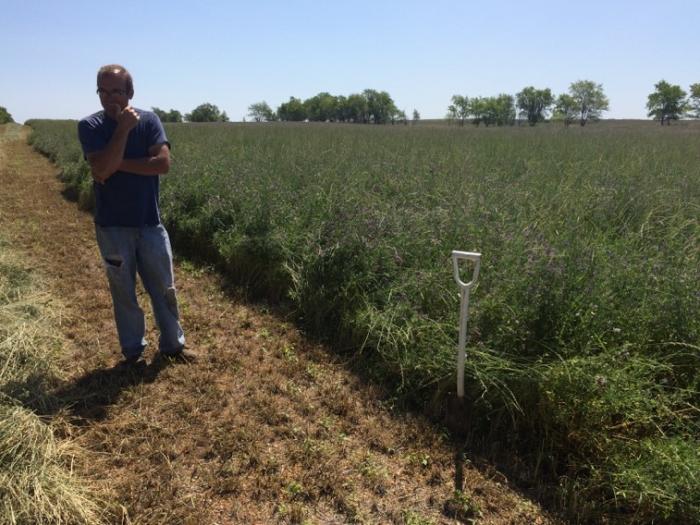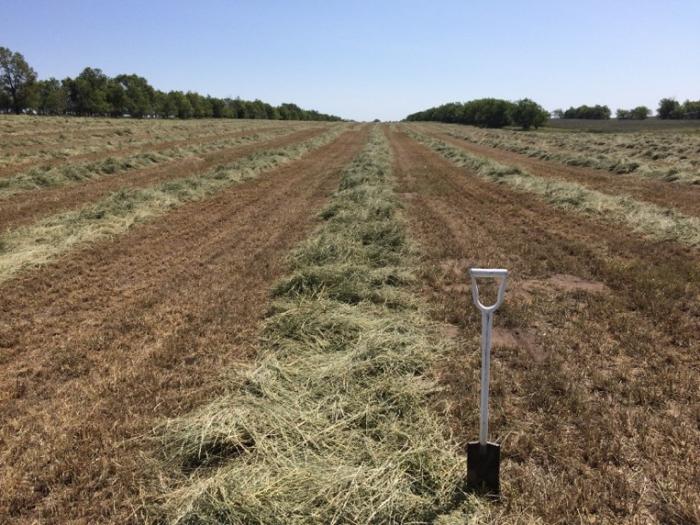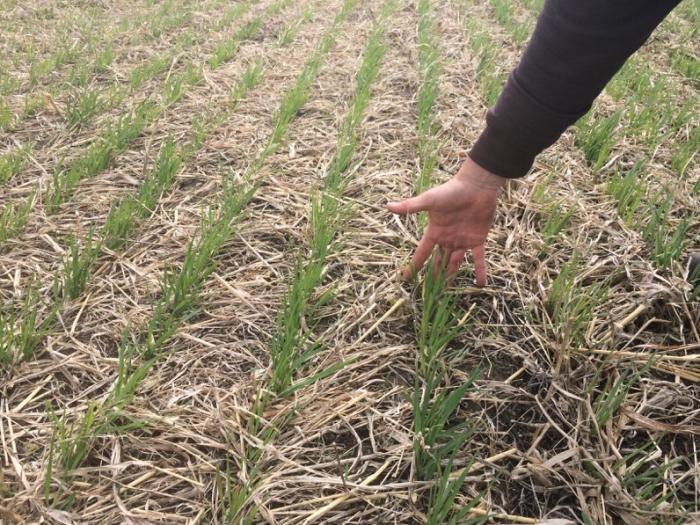Conservation Practices Helps Smalls Cope With Drought in Burleigh County
When Mike and Becky Small swathed hay during the extreme drought last summer, they were surprised with one particular piece of acreage.
Luann Dart writes form Elgin, N.D.
A hayfield that had been reseeded with a mixture of legumes and grasses had yielded four bales per acre, double what the field had yielded previously.

“The benefits were amazing,” Becky said.
The Small family ranch is located southeast of Moffit in Burleigh County, with a cow/calf operation that also grows hay and forage grain. They raise about 300 head of Angus cattle on 2,400 acres, which includes about 250 acres of cropland where they grow corn for silage and oats, along with cover crops.
Since 2008, they’ve been making changes on the ranch by utilizing the Environmental Quality Incentives Program (EQIP) through the Burleigh County Natural Resources Conservation Service (NRCS). They are starting to see the benefits, including in that alfalfa field.
About three years earlier, the Smalls had reseeded the 20 acres with a mix including 30% alfalfa; 20 percent cicer milk vetch (a legume high in protein that takes three years to mature); 20% sainfoin; and 30% intermediate wheatgrass. The mix was recommended by the NRCS, and the Smalls remained patient as the legumes and grasses took root. But the results appeared last year, during a particularly tough year for pastures and fields.
“It was surprising, so we were sold on the concept,” Becky said.
The Small ranch has implemented other conservation practices that helped them through the drought last summer, and which have resulted in overall environmental and financial benefits, according to the NRCS.
“One thing I have learned from interacting with the Smalls is that this family is creative and flexible in terms of dealing with the cards Mother Nature deals them. Their management decisions are calculated and carefully considered. And there is a plan B and C ready to be executed,” said David Pfliiger, NRCS District Conservationist, Burleigh County.
Before working with the Burleigh County NRCS, the Smalls utilized five pastures with five herds of cattle. In 2008-2009, they used the EQIP program to help fund fencing and water pipelines to create 35 pastures in that same area.
“Knowing our pastures were hurting and knowing something had to be changed, Mike went to some tours and saw it firsthand,” Becky said.
Each paddock averages about 50 acres, and about 100 head graze in each paddock for five to seven days twice a season. This system shortens the exposure time and lengthens rest and recovery.
The Smalls have extended their grazing season by installing a frost-free water pipeline more than a mile to cropland planted in cover crops, where the cattle graze until Jan. 1.
“We used to bring our cattle home and start feeding them by October, so now we extended our grazing by quite a bit,” Becky said.

With more intensive grazing, the Smalls have noticed improvements in their pastures.
“We’re seeing different species of grasses through the years. Some of them even get to seed out,” Mike said. “We’re shooting for 70 to 90 days rest before we come back in again. We got through the drought year. Didn’t have to worry.”
About the same time, they implemented more intensive rotational grazing, the Smalls also started planting full-season cover crops to supplement grazing and improve soil health.
In 2008, they planted a late-season cover crop after harvest, letting it grow about a foot, then allowing the cows to graze it.
“It was like chocolate. They just cleaned it,” Mike said. The last-season crop was a mixture of radish, turnips, millet and sorghum-sudangrass. The fall cover crop was a one-time experiment for the Smalls, as they now only plant full-season cover crops.
Full-season cover crops, planted around June 1, are a mixture of radish, turnip, pearl millet, sorghum-sudangrass, cowpea and hairy vetch.
Planting the cover crops is allowing the soil health to improve, Mike explained.
“Finding earthworms is kind of exciting,” he said.
With sandy soil, he plans to incorporate more sorghum-sudangrass this year to get more cover.
The couple also implemented no-till in 2008, reducing the amount of machinery they owned and cutting fuel costs. They’ve also noticed the radish roots now penetrate the soil deeper, rather than veering right or left after hitting the hardpan, which will benefit water infiltration and compaction issues.

The cover crops are also used during weaning, to take the calves out of the corral and reduce sickness while they’re being weaned.
The calves are weaned, penned for about three days, then turned into a cover crop of two to three species. The eight-acre field is grazed for about a week. The field is adjacent to the corrals, so the calves travel between the corral and field for water and supplemental feed, eventually transitioning full time into the feedlot.
Another NRCS program implemented at the ranch is monitoring livestock using the nutritional balancer program. This includes sending in frozen manure samples to determine the quality of grass or rations consumed. Mineral or corn distillers can then be added for more protein if the pastures are lacking proper nutrition. With an intensive grazing system, however, quick movement away from the pasture before the sample is tested proved to be a challenge.
The Smalls intend to continue with the program, adding supplements when the cattle return to the paddock the second time, if needed.
The Smalls are also enrolled in the Conservation Stewardship Program (CSP), which encourages conservation enhancements. Under the CSP, they planted tracts in cover crops and pastureland to monitor bee populations.
“That was fun to see the bee activity,” Becky said. It was beneficial for their family to monitor the pollinator activity and learn about the importance and benefits of pollinators, she said.
The Smalls appreciate the expertise of NRCS in helping them transition their ranch using conservation practices that are improving their livestock and soil health.
“It’s nice to be able to turn to them and see what can we try,” Becky said.
“They are willing to do things different and better using today’s science and technology, especially those that build the quality and health of their soil. They dare to think outside the box and aren’t afraid to break from cultural habits. The hard work is obvious to me and so is the passion and pride that goes with it. The signature that they place on the landscape is one that I study,” Pfliiger said.

